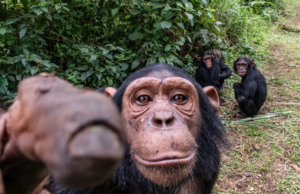How chimpanzees communicate

A recent work signed by several primatologists of University of St. Andrews, in UK, published in the journal Current Biology, shows how a group of free-living chimpanzees in the Budongo Forest, Uganda, developed a language of gestures, to communicate between them. Primatologists who carried out this work came to develop a dictionary of gestures that this group of 80 chimps would use to understand one another day by day.
For us who live with chimpanzees in Sorocaba Sanctuary, this is nothing new. In the language of gestures, should be added the ones of attitudes and of sounds, as well as understanding of our words. After years of coexistence between humans and great apes, the form of communication between us is even more complex, rich in detail and includes the human word in it.
When I talk with a chimp, he understands what I want to say to him, and he usually answers me with a gesture or a sound, or an attitude. When chimp Luke, for example, asks me to play with him, he makes an appropriate gesture, knowing that I already understand. When I want him to come to play or do grooming, I talk to him a few words, because I know he understands them, and accompany with appropriate gestures.
Through the interaction of years, we have a form of communication much more evolved than the simple gestures, observed in free-living chimpanzees, with little human contact, as our word is now understood by chimpanzees, as well as the sounds and gestures that we understand.
When they want something, they know how to ask, as well as we know how to ask them something so that they will understand us immediately. Civilized chimpanzees, especially those who have no mental problems, as they were raised at the sanctuary since they were babies, know how to communicate and interact with humans who surround them with great ease and efficiency. We have our own language, which is a mixture of gestures, attitudes, words, phrases and sounds. Perhaps, some of the babies and adolescents of the Sanctuary someday will be able to enhance communication with humans, becoming understood more accurately and understand what we want to teach them.
As I always say, we learn to talk only about 50,000 years ago. The early Homos communicated with gestures, attitudes and sounds that were not words. Gradually those sounds became words and the same were articulated in sentences, emerging in the human language; they beings who did not speak, but they still were considered humans. This is something we deny to chimpanzees today.
Those who can live for a few hours with us, in the relationship between humans and chimpanzees, may think that we go crazy, since they will see us talking to them with words and gestures, and they correspond with sounds and gestures.
The Sanctuary is not a world of silence as many may imagine. It is a world rich in images, gestures, attitudes, words and sounds; a way that they and we have developed through the years, so we can live together and understand each other in that world of different species.
There is also the mind-reading. In a recent article published in the newspaper Estado de S. Paulo, biologist Fernando Reinach deepens the theme, from the mental to lip reading. This is also another feature that chimpanzees possess. They are great observers and watch us trying to penetrate our thoughts, and know what we are thinking at a specific time, or what we want to convey to them. The more the observer is an individual – whether a human primate or not – more the person has capacity to read the minds of others, thus making understanding and being understood. Mind reading is another of the qualities that the chimps develop in their way of communicating between them and us. Probably among them mind-reading is much more precise than with humans. Observing each other, they can interpret and anticipate the actions and desires of other primates, facilitating interaction and communication between them.
Many surprises await us in the future. We will come to understand that our species is not all that you think and others are more similar in all directions, more than we are willing to accept today.
Dr. Pedro A. Ynterian
President, GAP Project International

 Español
Español
 Português
Português








